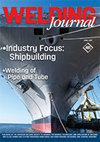涂层和焊丝成分对AHSS GMA焊缝的影响
IF 1.4
3区 材料科学
Q2 METALLURGY & METALLURGICAL ENGINEERING
引用次数: 2
摘要
先进的高强度钢(AHSS),如复相(CP)和高成形性(HF)钢,为汽车应用(如底盘和车架应用)提供了重量节省优势。为了防止材料氧化,通常对材料进行镀锌,以保护基材免受腐蚀。然而,由于锌在焊接熔池中的截留,涂层AHSS的可焊性变得具有挑战性,这可能导致焊接缺陷,如气孔和液态金属脆化裂纹。本工作重点研究了采用气体保护焊工艺的AHSS(CP800和980HF)的可焊性。研究了镀锌铁涂层和填充材料对焊缝强度的影响。使用两种不同的填充材料进行焊接:低强度填充材料(ER70S-6)和高强度填充(ER100S-6)材料。此外,还研究了两种不同的接头配置:搭接接头和对接接头。结果表明,与搭接接头相比,对接接头具有更高的强度。此外,在所有测试材料(镀锌和无涂层)中,对接接头的强度都超过了基材的强度。一般来说,搭接接头强度与基体材料强度不匹配,这是由于拉伸试验期间的旋转在搭接接头上产生了不合理的弯曲应力,而使用更高强度的焊丝提高了搭接接头结构中的抗拉强度材料。980HF钢的硬度分布也显示出显著的硬度失配,这是由于在热影响区形成了完全马氏体微观结构,从而抑制了整个搭接接头的变形。本文章由计算机程序翻译,如有差异,请以英文原文为准。
Effect of Coating and Welding Wire Composition on AHSS GMA Welds
Advanced high-strength steels (AHSS) such as complexphase (CP) and high-formability (HF) steel offer weightsaving advantages for automotive applications such as chassis and frame applications. To prevent material oxidation, materials are often galvanized to protect the substrate from corrosion. However, the weldability of coated AHSS becomes challenging due to the trapping of zinc in the weld molten pool, which could lead to weld defects such as porosity and liquid metal embrittlement cracks. This work focused on the weldability of AHSS (CP800 and 980HF) using the gas metal arc welding process. The roles of both galvanized iron coating and filler material on weld strength were investigated. The welds were performed using two different filler materials: a low-strength filler (ER70S-6) and a high-strength filler (ER100S-6) material. In addition, two different joint configurations were studied: lap joints and butt joints. The results showed that the butt joint had a higher strength compared to the lap joints. Furthermore, the strength of the butt joint overmatched the base material strength in all of the tested materials (both in galvanized and uncoated). In general, lap joint strength undermatched the base material strength, which was attributed to the rotation during tensile testing that induced unaccounted bending stress on the lap joint, while using a higherstrength welding wire improved the tensile strength material in the lap joint configuration. The hardness profiles in the 980HF steel also showed a significant hardness mismatch due to the formation of a fully martensitic microstructure in the heat-affected zone, which led to suppressing the deformation across the lap joint.
求助全文
通过发布文献求助,成功后即可免费获取论文全文。
去求助
来源期刊

Welding Journal
工程技术-冶金工程
CiteScore
3.00
自引率
0.00%
发文量
23
审稿时长
3 months
期刊介绍:
The Welding Journal has been published continually since 1922 — an unmatched link to all issues and advancements concerning metal fabrication and construction.
Each month the Welding Journal delivers news of the welding and metal fabricating industry. Stay informed on the latest products, trends, technology and events via in-depth articles, full-color photos and illustrations, and timely, cost-saving advice. Also featured are articles and supplements on related activities, such as testing and inspection, maintenance and repair, design, training, personal safety, and brazing and soldering.
 求助内容:
求助内容: 应助结果提醒方式:
应助结果提醒方式:


